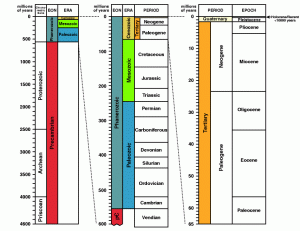Although corals are considered one of the earliest, most primitive animal groups on the planet, the stony corals that grace our reef aquariums with color and vibrance actually arose later than some of us have been led to believe.

Source: talkorigins.org
It is widely accepted that our ocean’s corals have been derived from sponge-like ancestors; however, the first “corals” to be derived from these sponge-like ancestors are not the ones we see in our reef aquariums.
Roughly 500 million years ago in the Ordovician period (see table to the left), two orders of stony corals arose. These groups are known as Rugosa and Tabulata.

Rugosa
Soon after these two groups of corals arose from their presumably spongy ancestors, they attained prominence in our oceans and helped construct reefs with the help of their stable, calcite-based skeletons.
These corals maintained their oceanic dominance until the mysterious Permian – Triassic extinction, which is thought to have been responsible for their demise. If these two groups abruptly became extinct, leaving our planet virtually devoid of corals, how do living coral species exist on earth today?
Several millions of years into the Triassic period, another group of corals arose. Since Tabulata and Rugosa are thought to have already become extinct at this point, many paleobiologists hypothesize that this new group of corals had not been derived from one of these extinct groups, but came from sponge-like ancestors, just as the two extinct groups did during the Ordovician period. This hypothesis; however, has been countered by recent findings of fossil corals that host features of both Rugosa and the new group – Scleractinia. This suggests the possibility that Scleractinians – the corals that populate our planet today, may have been derived from ancient Rugosa corals.

Veron, 2009










There are some major flaws with this post. First, corals are not “derived from sponges”; this is a complete misunderstanding of how the process of evolution works to create new species and groups. While sponges have generally been considered the most primitive multicellular animals, they are their own unique monophyletic branch. They do, at some point in their evolutionary history, share a common ancestor with corals… just as they do with anything else on this planet. To wit, corals did not evolve from sponges. There is also an increasing amount of data that indicates that ctenophores may actually be the most basally diverging branch of multicellular animal life. Sponges are now known to possess genes used in the formation of nervous tissue, meaning that their seemingly simple bodyplan is due to a reversal of the ancestral condition.
http://whyevolutionistrue.wordpress.com/2013/12/20/the-outgroup-for-animals-ctenophores/
Furthermore, there is now thought to be a direct link between the rugosan corals to modern scleractinia. The three characters that separated these groups (aragonitic vs calcitic skeletons, serial vs cyclic septal insertion patterns, and the triassic fossil gap) have been bridged with new findings. The scleractiniomorph corals (e.g. Numidiaphyllum, Kilbuchophyllia) show intermediate forms between rugosa and scleractinia, and the fossil gap is now presumed to indicate a period of skeletal loss.
http://www.biomedcentral.com/1471-2148/11/316
Thanks for the suggestions, Joe. I have since edited this article. Enjoy your weekend.
One final quibble: the common ancestor of sponges and cnidarians (and placozoans) would not have been “spongy”, but rather would have resembled the common larval form of a ciliated or flagellated sphere. Consider the cnidarian planula, poriferan parenchymella, and placozoan and you can get a rough idea of what the common ancestor would look like. Ontogeny recapitulates phylogeny. Cheers.
Here’s an excellent paper which provides background on this metazoan common ancestor.
http://www.ecolevol.de/pubs/2012/Osigus_MPE_2012.pdf